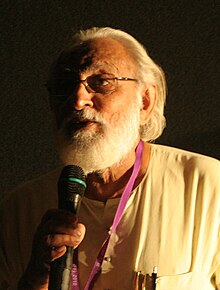MS Sathyu
| Mysore Srinivas Sathyu | |
|---|---|

M. S. Sathyu in 2010
|
|
| Native name | ಮೈಸೂರು ಶ್ರೀನಿವಾಸ ಸತ್ಯು |
| Born | Mysore, Kingdom of Mysore |
| Nationality | Indian |
| Occupation | Film director Stage Designer Art Director |
| Known for | Garam Hawa |
Mysore Shrinivas Sathyu (born in Mysore, Karnataka) is a leading film director, stage designer and art director from India. He is best known for his directorial film Garam Hawa (1973) is based on the partition of India. He was awarded Padma Shri in 1975.
Sathyu conducted his schooling and higher education at Mysore and Bangalore. In 1952, he quit college while working on his Bachelor of Science degree and instead plunged into the uncertain world of films in Bombay.
He freelanced as an animator in 1952–53. After being unemployed for nearly four years, he got his first salaried job as assistant director to filmmaker Chetan Anand.
His wife is Shama Zaidi.
His first assignment as an independent Art director was for Haqeeqat, a film by Chetan Anand, which got him the Filmfare Award in 1964 and along with that came recognition. He also did work in theatre as a designer and director, including designing sets and lights for productions of Hindustani Theatre, Okhla Theatre of Habib Tanvir, Kannada Bharati and other groups of Delhi. In films, he has worked as an art director, camera-man, screenwriter, producer and director. His filmography includes over 15 documentaries and 8 feature films in Hindi, Urdu and Kannada.
His best known work, Garam Hawa (Scorching Winds, 1973), is one of the last cinema productions featuring 1950s Marxist cultural activists including Balraj Sahni and Kaifi Azmi. Garam Hawa won several Indian national awards in 1974, including a National Integration Award. It was invited for the competitive section at Cannes and also the Indian entry at the Oscars, and achieved a Filmfare award for best screenplay.
...
Wikipedia
